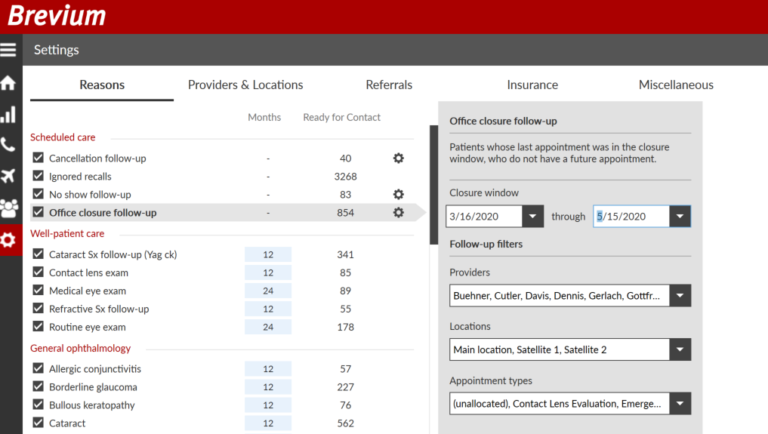The Brevium Blog

Five Patient Follow-Up Mistakes You Might Be Making, and How to Fix Them
Follow-up with patients after a visit is the most important component to ensuring they comply with their doctor’s advice and return to the practice for recare. Yet, many practices frequently make missteps that complicate their patient follow-up protocol or process. The good news is that identifying and fixing these mistakes is easy when you know what to look for. In this article, we identify five mistakes you might be making and provide fixes to make your follow-up with patients more effective without adding a burden to your staff.
Mistake #1: Letting patients leave the office without making a follow-up appointment
Too often, patients leave the practice when their visit with their caregiver is done. They don’t stop at the front desk to schedule a follow-up visit, because they’re thinking about the visit they just finished, and they are not aware of your process for scheduling appointments. Just like that, your patients are out the door, and now your practice has to go through the trouble of determining who needs follow-up visits and contacting and scheduling those patients.
How to fix this: Scheduling patients while they are in the office is so much easier. The front-office staff should have the responsibility of interacting with each patient before they leave. Ensure the staff checks the caregiver’s notes and schedules patient follow-ups. This is also an excellent time to thank the patient for their visit, ask them about their experience, and ask for a review or referrals.
Mistake #2: Sending disorganized appointment reminders
No shows for appointments are a real problem, and one of the best ways to avoid them is with automated patient appointment reminders. Surprisingly, many practices still employ inconsistent phone and postcard reminders rather than depending on technology to make this task easy.
How to fix this: You can save your office staff time and reduce late shows and no shows for appointments by using automated appointment reminder systems such as Brevium to send emails, texts, and automated or live phone calls, depending on the patient’s preferences. You can also customize patient appointment reminders to go a set number of days before each appointment, also depending on the patient and their reliability history.
Mistake #3: Eliminating phone calls from your follow-up processes
As you depend more on your automated appointment systems to run your office more efficiently, time-intensive phone calls are one of the first tasks you might eliminate. However, our studies have shown that phone calls are still the most effective way to communicate with patients.
How to fix this: You can run your office efficiently and still employ live phone calls with patients by using patient follow up software such as Brevium to schedule live or even automated phone calls. A phone call is also a good way to determine the patient’s compliance with their doctor’s advice and prescriptions.
Mistake #4: Not sending a thank-you message
Most healthcare practices do not send thank-you notes to patients as part of their standard communications. However, studies show that patients feel more appreciated and cared for when they receive a thank-you message from their doctor. When patients make this connection with their doctor, they are more likely to stay in compliance and to continue their recare visits.
How to fix this: Adding a thank-you note via email or text is easy using patient follow up software such as Brevium. The returns will far exceed your investment in the time it takes to set this up.
Mistake #5: Not asking for a review
More than 80 percent of patients depend on online reviews to select their healthcare providers. They are typically looking for star ratings of four or higher, other patients’ comments and the total number of patient reviews of doctors. [1] Too many practices are afraid to ask their patients for reviews, because they don’t realize that patients today are accustomed to providing reviews for many products and services and don’t find your asking to be offensive or unusual.
How to fix this: There are many excellent platforms for requesting patient reviews. In your patient follow-up email or text (you know, the one thanking them for their visit), also ask for their feedback and provide a link to Google, Facebook and Yelp. Remember that 70 percent of all patients and 80 percent of those 18 to 34 years old have written patient reviews. To set up a Google link, go to business.google.com. For Facebook, click “Create,” than “Page.” For Yelp, click “Go to Yelp for Business Owners.”
Brevium Can Help You Follow Up with Your Patients
Brevium is an expert in patient retention and the pioneer in patient reactivation. Brevium’s patient follow up software mines its clients’ patient databases using customized algorithms to improve the patient appointment lifecycle™. Hundreds of practices have found Brevium to be a trusted partner, with personalized training and unlimited support. Through original research and development of patient follow up software, Brevium helps ensure that patients return for the care they need, and practices derive the greatest financial benefit from the patient appointment lifecycle™.
I want to find out how Brevium can help me follow up with my patients.














